#William Clowes Ltd.
Text
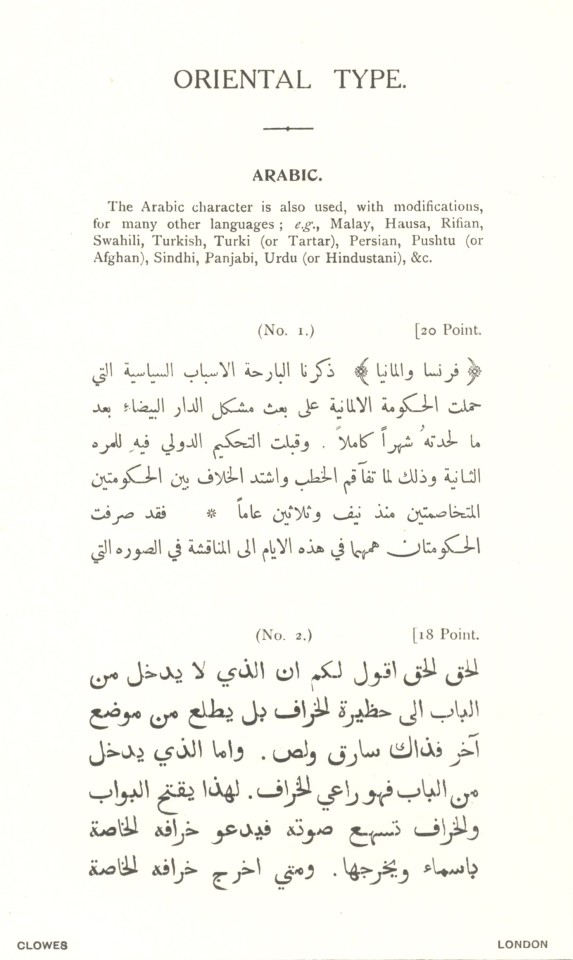



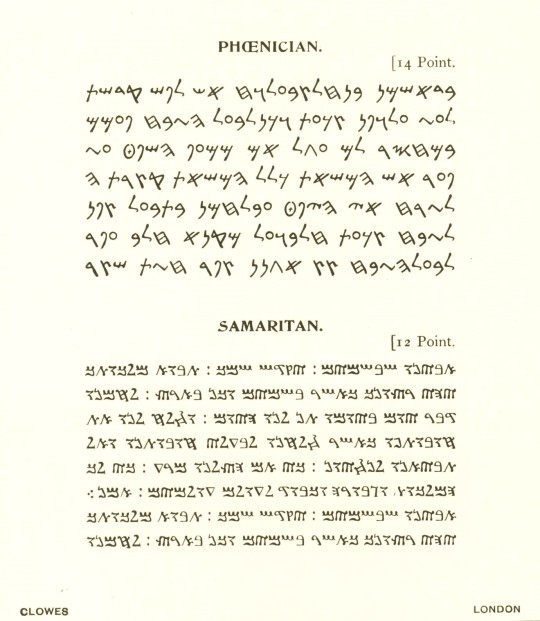

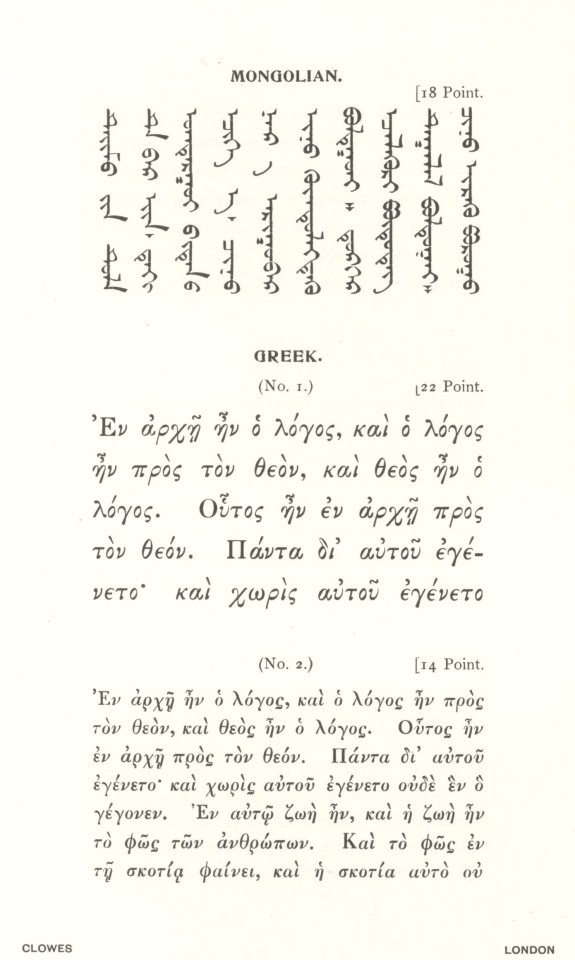


Typography Tuesday
This week we present some more non-Roman type from the 1908 type specimen book Some Specimens of the Roman, Oriental, and Foreign Types Now in Use in the Offices of William Clowes & Sons, Limited, published at the Clowes head office in London. Clowes was founded as a printing company in 1803 by William Clowes in London. By the early 1820s, Clowes became a pioneer in the use of steam-powered printing in England, and by mid-century William Clowes & Sons was one of the largest printing companies in the world, and is still in operation today. This specimen book presents all the fonts in use by the company at the turn of the 20th century.
View another post of non-Roman type from William Clowes & Sons.
View our other Typography Tuesday posts.
#Typography Tuesday#typetuesday#type specimen books#type display books#William Clowes#William Clowes & Sons#William Clowes Ltd.#typefaces#non-Roman typefaces#20th century type
77 notes
·
View notes
Photo

1930’s undated Andersen’s Fairy Tales by Hans Andersen illustrated by Rene Bull published by William Clowes & Sons Ltd - [ ] - [ ] #antiquarian #illustration_daily #bookshelf #antiquarianbookshop #americanantiquarian #illustration #illustrations #booksbooksbooks #childrenseemagic #childrensbooks #books #illustrationart #illustrationartists #bookshelves #childrensbook #childrensfashion #bookstore #childrens #antiquarianbook #books📚 #illustrationartist #antiquarianbooks #bookstagram #bibliophile #hansandersen #renebull #fairytales https://www.instagram.com/p/CAUivFEpqzY/?igshid=13nvq348uqirx
#antiquarian#illustration_daily#bookshelf#antiquarianbookshop#americanantiquarian#illustration#illustrations#booksbooksbooks#childrenseemagic#childrensbooks#books#illustrationart#illustrationartists#bookshelves#childrensbook#childrensfashion#bookstore#childrens#antiquarianbook#books📚#illustrationartist#antiquarianbooks#bookstagram#bibliophile#hansandersen#renebull#fairytales
0 notes
Link
(Bloomberg) -- A dream of building the world’s biggest hydroelectric project in the heart of Africa may be inching closer to reality.For decades, plans have been made and discarded to construct a series of hydroelectric power stations on the world’s second-longest river that would generate almost twice the power of the Three Gorges Dam in China, the world’s largest. If completed, a Grand Inga Dam could go a long way to addressing one of the most debilitating obstacles to development across Africa from Nigeria to South Africa: electricity shortages.“There’s not a single place in the world where you find such a concentration of hydropower as here,” Omer Kawende, an engineer with the national electricity company, said as he stood on a bridge at the site where swallows swooped under a misty sky. “This is absolutely exceptional.”The problem? It’s in Congo.A country two-thirds the size of Western Europe, Congo is one of the most difficult places on earth to get anything done. It’s ranked 184th out of 190 countries in the World Bank’s latest Doing Business report and regularly tops Transparency International’s index of most corrupt nations. It’s been brought to its knees by dictatorship, rebellions, and head-splitting bureaucracy since the end of Belgian colonial rule in 1960.Investors On BoardLate last year there was a sudden burst of activity around Grand Inga. Then-President Joseph Kabila signed an accord in October with two groups of Chinese and Spanish investors, who committed to funding technical studies before building and running an 11,050-megawatt facility called Inga III at a cost of $14 billion. The consortia, which include AEE Power Holdings SL and China Three Gorges Corp., also pledged to attract lenders and find buyers of the electricity elsewhere in Africa.That could be news of revolutionary import to Congo’s 80 million people, who make do with about 1,500 megawatts, about as much as typically needed for a city of 1 million in industrialized nations. Grand Inga could single-handedly generate more than 40,000 megawatts upon completion.For now though, outages are a near-daily occurrence in the capital, Kinshasa, and in huge swathes of the country there’s no power at all. About 19% of Congolese have access to electricity, the lowest percentage among African countries after Burundi, according to the World Bank.Poor MaintenanceTwo dams built on the same stretch of the Congo River more than three decades ago, Inga I and Inga II, still provide most of the nation’s power but have often run below capacity due to poor maintenance, while rehabilitation has proved slow and costly.“Every day the electricity comes and goes -- it’s a bit like living in the village,” said Yannick Tshiamala, a 33-year-old university graduate who helps his father run a barbershop and a car-repair business on an unpaved street in Kinshasa. “If you wake up in the morning without electricity, you have to figure out where to charge your phone and where to iron your clothes.”All eyes are now on Kabila’s successor, Felix Tshisekedi, who’s vowed to connect half of the population to the national grid over the next decade. Inga III, his advisers say, is one of his priorities -- even though Tshisekedi hasn’t confirmed he’ll stick with the Spanish and Chinese consortia, which have yet to be awarded a concession contract.“We’re going at cruising speed,” said Michel Eboma, Tshisekedi’s chief adviser for mines and energy. “The president has the general interest of the people at heart, and Inga III aims at improving the life of the population.”China’s ApproachMuch will depend on China’s attitude. While President Xi Jinping’s government supports the project, he’s increasingly working to ensure that his Belt and Road Initiative doesn’t leave poorer nations with unsustainable debt. The uncertainty surrounding China’s approach has caused dislocations in projects across Africa.In Kenya, construction of a flagship railway from the coast to Uganda was halted after China withheld some $4.9 billion in funding. In Zimbabwe, a giant solar project hit a cash shortfall after China’s Export Import Bank backed out due to the government’s legacy debts. In Ethiopia though, Chinese contractors were hired earlier this year to accelerate work on the long-delayed Grand Renaissance Dam, which had been mired for years in design and management conflicts.Inga III “has to be a project that guarantees repayment of loans because the financial budget of the government is very limited,” said Wang Tongquing, China’s ambassador to Congo. “According to the information I have, the plans of this project are not yet very mature, above all the plan for the consumption of the electricity after construction.”Not all Congolese are convinced that the dam will solve the nation’s desperate lack of energy. In its current form, most of the power it will generate is meant for other countries.More than 30 civil-society leaders published an open letter to the president in March, saying Inga III risks loading Congo with debt and won’t provide help for most of its people. And, while parliament approved a bill five years ago to liberalize the energy sector, Congo still lacks an independent energy regulator.“The need for electricity among the population is enormous and Inga III could -- I say could -- improve the situation,” said Madeleine Andeka, one of the letter’s signatories. “It’s not bad in itself that we would supply power to mining companies and other countries, but I’m not sure how we would benefit as a host country.”South African InterestToday no country in the region is more interested in the development of Inga III than South Africa, which is struggling with power shortages from its aging coal-fired plants.In 2005, state power utility Eskom SOC Holdings Ltd. developed a $50 billion plan for both Inga III and Grand Inga, but it never got off the ground. South Africa has since signed a treaty with Congo to buy 2,500 megawatts from the facility and said last year it might double that amount.The African Union now wants to be involved too. Inga “must be a pan-African project” because more than 70% of its power will go to consumers outside Congo, said a spokesman for the organization’s high representative for infrastructure development, Raila Odinga, who visited the site in May.“We need to develop Inga as a continent and link it to the different power pools that already exist,” Odinga said in comments sent by his office.Early SuccessInga’s potential was recognized as far as back as 1921, when the U.S. Geological Survey estimated that the basin had a quarter of the world’s hydroelectric potential.The construction of the first two dams, Inga I and Inga II, in the heady, post-independence years under then President Mobutu Sese Seko, generated power that lit up the capital and supplied the mining industry, Congo’s only source of export revenue.While Inga I began operating in 1972 and was considered a success, Inga II required transmission lines over 1,100 miles of rainforest to reach the mines of Katanga province and loaded the country with massive debt as copper prices were plummeting in 1982.The slow collapse of Mobutu’s dictatorial regime and a subsequent civil war paralyzed progress on Inga III. After peace returned in 2003, several investors lined up to work at Inga, only to get squeezed out or withdraw later. Just one dam has been completed since the 1980s -- a 150-megawatt plant built by China’s SinoHydro Corp. But construction took three years longer than planned and transmission lines still haven’t been built.While the nation awaits progress on Inga, some Congolese businessmen are forging ahead with plans for smaller dams. Among them is Yves Kabongo, chief executive officer of Great Lake Energy, who recently finalized a contract with PowerChina Ltd. for a 900-megawatt facility on the Congo river that’s designed to supply the mining industry.“Let’s be realistic -- Inga III is a huge undertaking,” Kabongo said. “It’ll take years -- you need to reassure investors, you need to have a sound economy. We have projects that are much smaller and quicker to realize, because we’re private citizens.”To contact the reporters on this story: Pauline Bax in Kinshasa at [email protected];William Clowes in Kinshasa at [email protected] contact the editors responsible for this story: Paul Richardson at [email protected], Karl Maier, Benjamin HarveyFor more articles like this, please visit us at bloomberg.com©2019 Bloomberg L.P.
from Yahoo News - Latest News & Headlines https://ift.tt/2YL0jVM
0 notes
Text
Three Gorges Has Nothing on China-Backed Dam to Power Africa
(Bloomberg) -- A dream of building the world’s biggest hydroelectric project in the heart of Africa may be inching closer to reality.For decades, plans have been made and discarded to construct a series of hydroelectric power stations on the world’s second-longest river that would generate almost twice the power of the Three Gorges Dam in China, the world’s largest. If completed, a Grand Inga Dam could go a long way to addressing one of the most debilitating obstacles to development across Africa from Nigeria to South Africa: electricity shortages.“There’s not a single place in the world where you find such a concentration of hydropower as here,” Omer Kawende, an engineer with the national electricity company, said as he stood on a bridge at the site where swallows swooped under a misty sky. “This is absolutely exceptional.”The problem? It’s in Congo.A country two-thirds the size of Western Europe, Congo is one of the most difficult places on earth to get anything done. It’s ranked 184th out of 190 countries in the World Bank’s latest Doing Business report and regularly tops Transparency International’s index of most corrupt nations. It’s been brought to its knees by dictatorship, rebellions, and head-splitting bureaucracy since the end of Belgian colonial rule in 1960.Investors On BoardLate last year there was a sudden burst of activity around Grand Inga. Then-President Joseph Kabila signed an accord in October with two groups of Chinese and Spanish investors, who committed to funding technical studies before building and running an 11,050-megawatt facility called Inga III at a cost of $14 billion. The consortia, which include AEE Power Holdings SL and China Three Gorges Corp., also pledged to attract lenders and find buyers of the electricity elsewhere in Africa.That could be news of revolutionary import to Congo’s 80 million people, who make do with about 1,500 megawatts, about as much as typically needed for a city of 1 million in industrialized nations. Grand Inga could single-handedly generate more than 40,000 megawatts upon completion.For now though, outages are a near-daily occurrence in the capital, Kinshasa, and in huge swathes of the country there’s no power at all. About 19% of Congolese have access to electricity, the lowest percentage among African countries after Burundi, according to the World Bank.Poor MaintenanceTwo dams built on the same stretch of the Congo River more than three decades ago, Inga I and Inga II, still provide most of the nation’s power but have often run below capacity due to poor maintenance, while rehabilitation has proved slow and costly.“Every day the electricity comes and goes -- it’s a bit like living in the village,” said Yannick Tshiamala, a 33-year-old university graduate who helps his father run a barbershop and a car-repair business on an unpaved street in Kinshasa. “If you wake up in the morning without electricity, you have to figure out where to charge your phone and where to iron your clothes.”All eyes are now on Kabila’s successor, Felix Tshisekedi, who’s vowed to connect half of the population to the national grid over the next decade. Inga III, his advisers say, is one of his priorities -- even though Tshisekedi hasn’t confirmed he’ll stick with the Spanish and Chinese consortia, which have yet to be awarded a concession contract.“We’re going at cruising speed,” said Michel Eboma, Tshisekedi’s chief adviser for mines and energy. “The president has the general interest of the people at heart, and Inga III aims at improving the life of the population.”China’s ApproachMuch will depend on China’s attitude. While President Xi Jinping’s government supports the project, he’s increasingly working to ensure that his Belt and Road Initiative doesn’t leave poorer nations with unsustainable debt. The uncertainty surrounding China’s approach has caused dislocations in projects across Africa.In Kenya, construction of a flagship railway from the coast to Uganda was halted after China withheld some $4.9 billion in funding. In Zimbabwe, a giant solar project hit a cash shortfall after China’s Export Import Bank backed out due to the government’s legacy debts. In Ethiopia though, Chinese contractors were hired earlier this year to accelerate work on the long-delayed Grand Renaissance Dam, which had been mired for years in design and management conflicts.Inga III “has to be a project that guarantees repayment of loans because the financial budget of the government is very limited,” said Wang Tongquing, China’s ambassador to Congo. “According to the information I have, the plans of this project are not yet very mature, above all the plan for the consumption of the electricity after construction.”Not all Congolese are convinced that the dam will solve the nation’s desperate lack of energy. In its current form, most of the power it will generate is meant for other countries.More than 30 civil-society leaders published an open letter to the president in March, saying Inga III risks loading Congo with debt and won’t provide help for most of its people. And, while parliament approved a bill five years ago to liberalize the energy sector, Congo still lacks an independent energy regulator.“The need for electricity among the population is enormous and Inga III could -- I say could -- improve the situation,” said Madeleine Andeka, one of the letter’s signatories. “It’s not bad in itself that we would supply power to mining companies and other countries, but I’m not sure how we would benefit as a host country.”South African InterestToday no country in the region is more interested in the development of Inga III than South Africa, which is struggling with power shortages from its aging coal-fired plants.In 2005, state power utility Eskom SOC Holdings Ltd. developed a $50 billion plan for both Inga III and Grand Inga, but it never got off the ground. South Africa has since signed a treaty with Congo to buy 2,500 megawatts from the facility and said last year it might double that amount.The African Union now wants to be involved too. Inga “must be a pan-African project” because more than 70% of its power will go to consumers outside Congo, said a spokesman for the organization’s high representative for infrastructure development, Raila Odinga, who visited the site in May.“We need to develop Inga as a continent and link it to the different power pools that already exist,” Odinga said in comments sent by his office.Early SuccessInga’s potential was recognized as far as back as 1921, when the U.S. Geological Survey estimated that the basin had a quarter of the world’s hydroelectric potential.The construction of the first two dams, Inga I and Inga II, in the heady, post-independence years under then President Mobutu Sese Seko, generated power that lit up the capital and supplied the mining industry, Congo’s only source of export revenue.While Inga I began operating in 1972 and was considered a success, Inga II required transmission lines over 1,100 miles of rainforest to reach the mines of Katanga province and loaded the country with massive debt as copper prices were plummeting in 1982.The slow collapse of Mobutu’s dictatorial regime and a subsequent civil war paralyzed progress on Inga III. After peace returned in 2003, several investors lined up to work at Inga, only to get squeezed out or withdraw later. Just one dam has been completed since the 1980s -- a 150-megawatt plant built by China’s SinoHydro Corp. But construction took three years longer than planned and transmission lines still haven’t been built.While the nation awaits progress on Inga, some Congolese businessmen are forging ahead with plans for smaller dams. Among them is Yves Kabongo, chief executive officer of Great Lake Energy, who recently finalized a contract with PowerChina Ltd. for a 900-megawatt facility on the Congo river that’s designed to supply the mining industry.“Let’s be realistic -- Inga III is a huge undertaking,” Kabongo said. “It’ll take years -- you need to reassure investors, you need to have a sound economy. We have projects that are much smaller and quicker to realize, because we’re private citizens.”To contact the reporters on this story: Pauline Bax in Kinshasa at [email protected];William Clowes in Kinshasa at [email protected] contact the editors responsible for this story: Paul Richardson at [email protected], Karl Maier, Benjamin HarveyFor more articles like this, please visit us at bloomberg.com©2019 Bloomberg L.P.
from Yahoo News - Latest News & Headlines
(Bloomberg) -- A dream of building the world’s biggest hydroelectric project in the heart of Africa may be inching closer to reality.For decades, plans have been made and discarded to construct a series of hydroelectric power stations on the world’s second-longest river that would generate almost twice the power of the Three Gorges Dam in China, the world’s largest. If completed, a Grand Inga Dam could go a long way to addressing one of the most debilitating obstacles to development across Africa from Nigeria to South Africa: electricity shortages.“There’s not a single place in the world where you find such a concentration of hydropower as here,” Omer Kawende, an engineer with the national electricity company, said as he stood on a bridge at the site where swallows swooped under a misty sky. “This is absolutely exceptional.”The problem? It’s in Congo.A country two-thirds the size of Western Europe, Congo is one of the most difficult places on earth to get anything done. It’s ranked 184th out of 190 countries in the World Bank’s latest Doing Business report and regularly tops Transparency International’s index of most corrupt nations. It’s been brought to its knees by dictatorship, rebellions, and head-splitting bureaucracy since the end of Belgian colonial rule in 1960.Investors On BoardLate last year there was a sudden burst of activity around Grand Inga. Then-President Joseph Kabila signed an accord in October with two groups of Chinese and Spanish investors, who committed to funding technical studies before building and running an 11,050-megawatt facility called Inga III at a cost of $14 billion. The consortia, which include AEE Power Holdings SL and China Three Gorges Corp., also pledged to attract lenders and find buyers of the electricity elsewhere in Africa.That could be news of revolutionary import to Congo’s 80 million people, who make do with about 1,500 megawatts, about as much as typically needed for a city of 1 million in industrialized nations. Grand Inga could single-handedly generate more than 40,000 megawatts upon completion.For now though, outages are a near-daily occurrence in the capital, Kinshasa, and in huge swathes of the country there’s no power at all. About 19% of Congolese have access to electricity, the lowest percentage among African countries after Burundi, according to the World Bank.Poor MaintenanceTwo dams built on the same stretch of the Congo River more than three decades ago, Inga I and Inga II, still provide most of the nation’s power but have often run below capacity due to poor maintenance, while rehabilitation has proved slow and costly.“Every day the electricity comes and goes -- it’s a bit like living in the village,” said Yannick Tshiamala, a 33-year-old university graduate who helps his father run a barbershop and a car-repair business on an unpaved street in Kinshasa. “If you wake up in the morning without electricity, you have to figure out where to charge your phone and where to iron your clothes.”All eyes are now on Kabila’s successor, Felix Tshisekedi, who’s vowed to connect half of the population to the national grid over the next decade. Inga III, his advisers say, is one of his priorities -- even though Tshisekedi hasn’t confirmed he’ll stick with the Spanish and Chinese consortia, which have yet to be awarded a concession contract.“We’re going at cruising speed,” said Michel Eboma, Tshisekedi’s chief adviser for mines and energy. “The president has the general interest of the people at heart, and Inga III aims at improving the life of the population.”China’s ApproachMuch will depend on China’s attitude. While President Xi Jinping’s government supports the project, he’s increasingly working to ensure that his Belt and Road Initiative doesn’t leave poorer nations with unsustainable debt. The uncertainty surrounding China’s approach has caused dislocations in projects across Africa.In Kenya, construction of a flagship railway from the coast to Uganda was halted after China withheld some $4.9 billion in funding. In Zimbabwe, a giant solar project hit a cash shortfall after China’s Export Import Bank backed out due to the government’s legacy debts. In Ethiopia though, Chinese contractors were hired earlier this year to accelerate work on the long-delayed Grand Renaissance Dam, which had been mired for years in design and management conflicts.Inga III “has to be a project that guarantees repayment of loans because the financial budget of the government is very limited,” said Wang Tongquing, China’s ambassador to Congo. “According to the information I have, the plans of this project are not yet very mature, above all the plan for the consumption of the electricity after construction.”Not all Congolese are convinced that the dam will solve the nation’s desperate lack of energy. In its current form, most of the power it will generate is meant for other countries.More than 30 civil-society leaders published an open letter to the president in March, saying Inga III risks loading Congo with debt and won’t provide help for most of its people. And, while parliament approved a bill five years ago to liberalize the energy sector, Congo still lacks an independent energy regulator.“The need for electricity among the population is enormous and Inga III could -- I say could -- improve the situation,” said Madeleine Andeka, one of the letter’s signatories. “It’s not bad in itself that we would supply power to mining companies and other countries, but I’m not sure how we would benefit as a host country.”South African InterestToday no country in the region is more interested in the development of Inga III than South Africa, which is struggling with power shortages from its aging coal-fired plants.In 2005, state power utility Eskom SOC Holdings Ltd. developed a $50 billion plan for both Inga III and Grand Inga, but it never got off the ground. South Africa has since signed a treaty with Congo to buy 2,500 megawatts from the facility and said last year it might double that amount.The African Union now wants to be involved too. Inga “must be a pan-African project” because more than 70% of its power will go to consumers outside Congo, said a spokesman for the organization’s high representative for infrastructure development, Raila Odinga, who visited the site in May.“We need to develop Inga as a continent and link it to the different power pools that already exist,” Odinga said in comments sent by his office.Early SuccessInga’s potential was recognized as far as back as 1921, when the U.S. Geological Survey estimated that the basin had a quarter of the world’s hydroelectric potential.The construction of the first two dams, Inga I and Inga II, in the heady, post-independence years under then President Mobutu Sese Seko, generated power that lit up the capital and supplied the mining industry, Congo’s only source of export revenue.While Inga I began operating in 1972 and was considered a success, Inga II required transmission lines over 1,100 miles of rainforest to reach the mines of Katanga province and loaded the country with massive debt as copper prices were plummeting in 1982.The slow collapse of Mobutu’s dictatorial regime and a subsequent civil war paralyzed progress on Inga III. After peace returned in 2003, several investors lined up to work at Inga, only to get squeezed out or withdraw later. Just one dam has been completed since the 1980s -- a 150-megawatt plant built by China’s SinoHydro Corp. But construction took three years longer than planned and transmission lines still haven’t been built.While the nation awaits progress on Inga, some Congolese businessmen are forging ahead with plans for smaller dams. Among them is Yves Kabongo, chief executive officer of Great Lake Energy, who recently finalized a contract with PowerChina Ltd. for a 900-megawatt facility on the Congo river that’s designed to supply the mining industry.“Let’s be realistic -- Inga III is a huge undertaking,” Kabongo said. “It’ll take years -- you need to reassure investors, you need to have a sound economy. We have projects that are much smaller and quicker to realize, because we’re private citizens.”To contact the reporters on this story: Pauline Bax in Kinshasa at [email protected];William Clowes in Kinshasa at [email protected] contact the editors responsible for this story: Paul Richardson at [email protected], Karl Maier, Benjamin HarveyFor more articles like this, please visit us at bloomberg.com©2019 Bloomberg L.P.
August 06, 2019 at 05:00AM
via IFTTT
0 notes
Text
Staff Pick of the Week


The commemorative box created by the publisher.


Parts of the letter that Beatrix Potter wrote to her governess’s son, Noel.



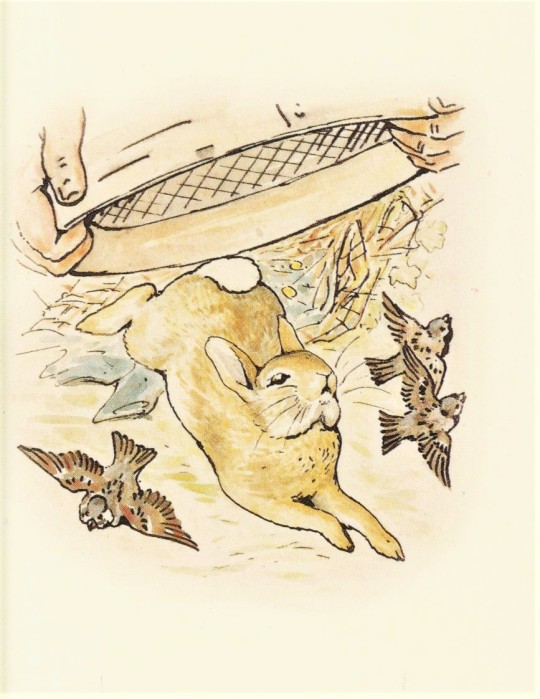

Staff Pick of the Week
Before The Tale of Peter Rabbit became a well-loved children’s book for those in England, and eventually spreading further, it was a story created for one special boy. Beatrix Potter was very fond of her last governess, Annie Moore, who had left her position in order to get married. The two women kept in touch and Beatrix was known to send Moore’s growing family illustrated letters featuring many animal friends. When Moore’s eldest son Noel fell ill, Beatrix wrote him one of her famous letters and Peter Rabbit was born.
The idea of publishing Peter Rabbit didn’t come to mind until it was suggested by fellow author, Canon Hardwicke Rawnsley. Despite Peter Rabbit’s monumental success presently, Potter’s story was rejected multiple times and she ended up publishing it herself in 1901, though it was a limited quantity and sold within her social circle. To no one’s surprise, however, it was a big hit! Frederick Warne & Co had rejected the idea the first time around but quickly reconsidered, if Beatrix would do the illustrations in color. This she did, and the first edition was published by Warne in October 1902. After that, the story took off, and is now a “must have” on children’s bookshelves.
To commemorate 100 years of the original Peter Rabbit picture letter of 1893, Frederick Warne & Co created this 1993 limited-edition commemorative box set in a limited edition of 1175 copies that includes a copy of the original Peter Rabbit letter and facsililes of her privately-printed edition of 1901 and the first deluxe Warne editon of 1902, all printed and bound by the venerable William Clowes Limited. Although it’s a facsimile, it was made to look and feel exactly like the original. It’s very convincing! I chose this book as my first staff pick not only because I like her artwork but because it looked like it might’ve been an original.
View another Beatrix Potter post.
View more Staff Picks.
-- Sarah W., Special Collections Undergraduate Intern
#Staff Pick of the Week#Beatrix Potter#The Tale of Peter Rabbit#facsimiles#Frederick Warne & Co#commemorative editions#William Clowes Ltd.#children's books#picture books#Historical Curriculum Collection#Sara W.
71 notes
·
View notes
Photo



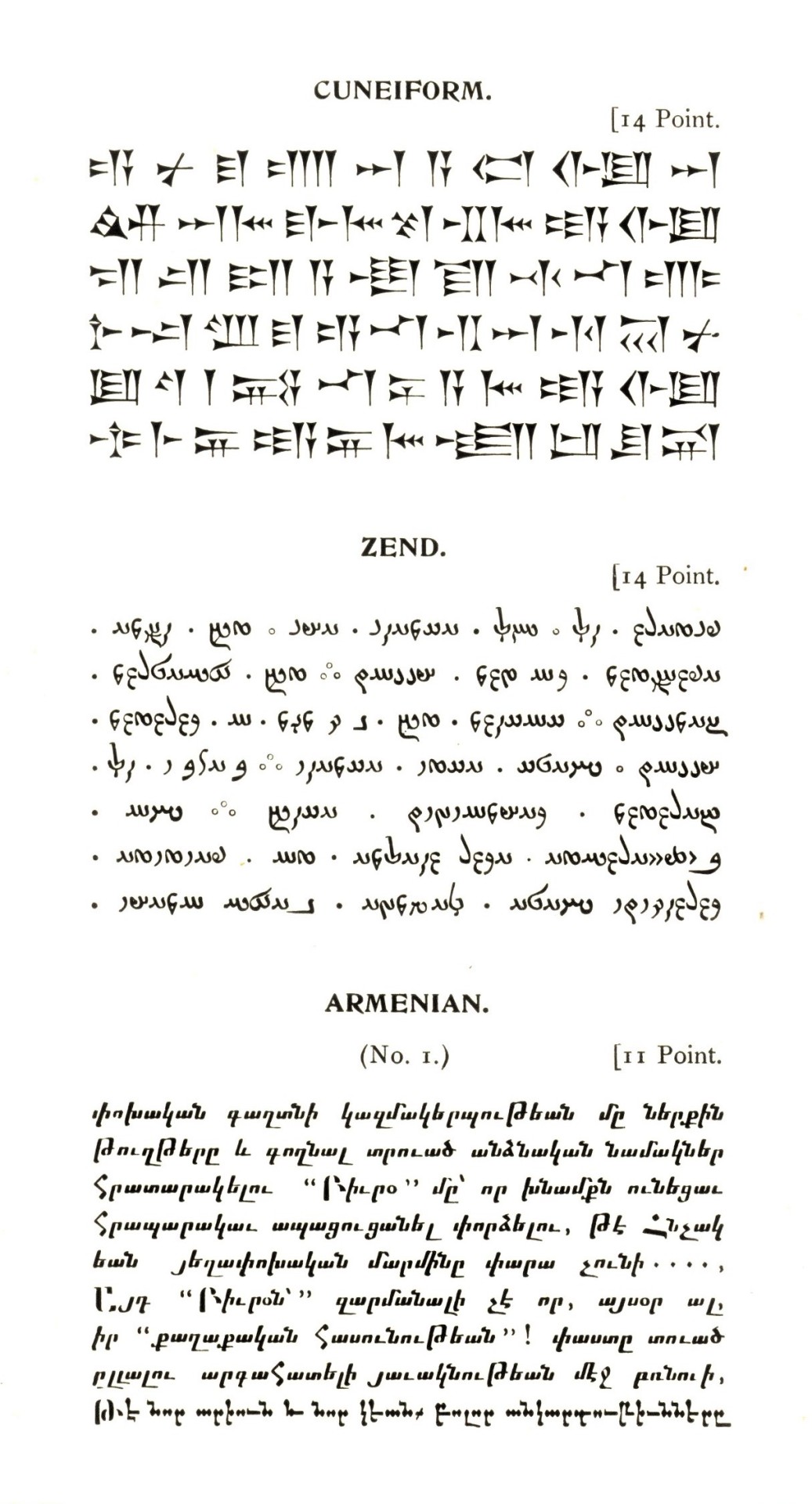

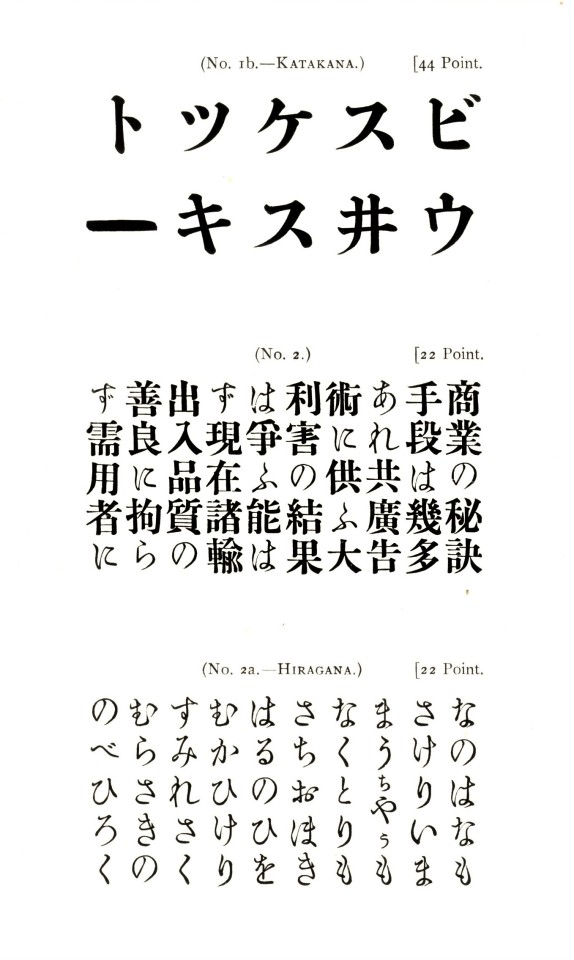




Typography Tuesday
This week we present some of the “Oriental and Foreign Founts” from our newly acquired 1908 type specimen book Some Specimens of the Roman, Oriental, and Foreign Types Now in Use in the Offices of William Clowes & Sons, Limited, published at the Clowes head office in London. Clowes was founded as a printing company in 1803 by William Clowes in London. By the early 1820s, Clowes became a pioneer in the use of steam-powered printing in England, and by mid-century William Clowes & Sons was one of the largest printing companies in the world, and is still in operation today. This specimen book purportedly presents all the fonts in use by the company at the turn of the 20th century. We can understand that Clowes had good purpose to use Asian, Middle-Eastern, and North African typefaces, and even Anglo Saxon and Anishinaabemowin (Chippewyan), but the use of Cuneiform and Egyptian Hieroglyphics must have been highly specialized.
In any event, we hope that you are as delighted as we are with these lovely displays of mainly non-Roman fonts.
View our other Typography Tuesday posts.
#Typography Tuesday#typetuesday#type specimen books#William Clowes#William Clowes & Sons#William Clowes Ltd.#typefaces#non-Roman typefaces#Typography Tuesday
86 notes
·
View notes
Photo
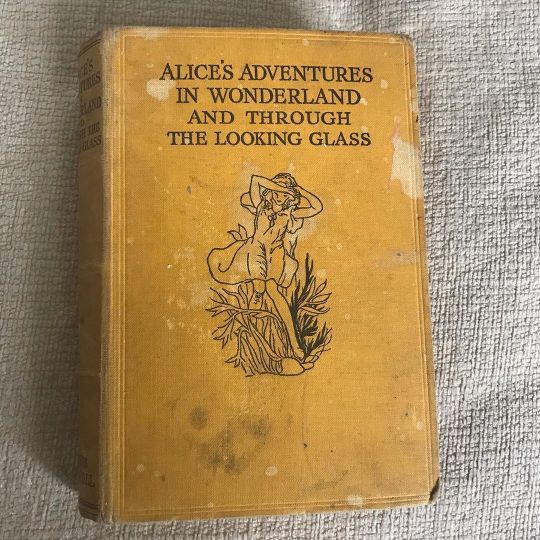
1930’s Alice’s Adventures In Wonderland & Through The Looking Glass by Lewis Carroll illustrated by Morton Sale published by William Clowes & Sons Ltd - [ ] - [ ] #antiquarian #illustration_daily #bookshelf #antiquarianbookshop #americanantiquarian #illustration #illustrations #booksbooksbooks #childrenseemagic #childrensbooks #books #illustrationart #illustrationartists #bookshelves #childrensbook #childrensfashion #bookstore #childrens #antiquarianbook #books📚 #illustrationartist #antiquarianbooks #bookstagram #bibliophile #lewiscarroll #Aliceinwonderland #mortonsale https://www.instagram.com/p/CAUhYOIp-pk/?igshid=vrvwqdzb2ed9
#antiquarian#illustration_daily#bookshelf#antiquarianbookshop#americanantiquarian#illustration#illustrations#booksbooksbooks#childrenseemagic#childrensbooks#books#illustrationart#illustrationartists#bookshelves#childrensbook#childrensfashion#bookstore#childrens#antiquarianbook#books📚#illustrationartist#antiquarianbooks#bookstagram#bibliophile#lewiscarroll#aliceinwonderland#mortonsale
0 notes